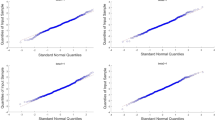Abstract
Doubly censored failure time data occur in many areas and for the situation, the failure time of interest usually represents the elapsed time between two related events such as an infection and the resulting disease onset. Although many methods have been proposed for regression analysis of such data, most of them are conditional on the occurrence time of the initial event and ignore the relationship between the two events or the ancillary information contained in the initial event. Corresponding to this, a new sieve maximum likelihood approach is proposed that makes use of the ancillary information, and in the method, the logistic model and Cox proportional hazards model are employed to model the initial event and the failure time of interest, respectively. A simulation study is conducted and suggests that the proposed method works well in practice and is more efficient than the existing methods as expected. The approach is applied to an AIDS study that motivated this investigation.
Similar content being viewed by others
References
Du M, Yu M (2023) Regression analysis of multivariate interval-censored failure time data with a cured subgroup and informative censoring. J Nonparametric Stat. https://doi.org/10.1080/10485252.2023.2280016
Du M, Zhou Q (2023) Analysis of informatively interval-censored case-cohort studies with application to HIV vaccine trials. Commun Math Stat. https://doi.org/10.1007/s40304-022-00322-6
De Gruttola V, Lagakos SW (1989) Analysis of doubly-censored survival data, with application to aids. Biometrics 45(1):1–11
Goggins WB, Finkelstein DM, Zaslavsky AM (1999) Applying the cox pro- portional hazards model for analysis of latency data with interval censoring. Stat Med 18(20):2737–2747
Gomez G, Lagakos SW (1994) Estimation of the infection time and latency distri- bution of aids with doubly censored data. Biometrics 50(1):204–212
Kim MY, De Gruttola VG, Lagakos SW (1993) Analyzing doubly censored data with covariates, with application to aids. Biometrics 49(1):13–22
Kim Y-J (2006) Regression analysis of doubly censored failure time data with frailty. Biometrics 62(2):458–464
Klein JP, Moeschberger ML (2003) Survival Analysis: Techniques for Censored and Truncated Data. Springer- Verlag, New York
Li Z, Owzar K (2016) Fitting cox models with doubly censored data using spline- based sieve marginal likelihood. Scand J Stat 43(2):476–486
Li S, Sun J, Tian T, Cui X (2020) Separametric regression analysis of doubly censored failure time data from case cohorts. Lifetime Data Anal 26:315–338
Pan W (2001) A multiple imputation approach to regression analysis for doubly censored data with application to aids studies. Biometrics 57(4):1245–1250
Sun J (1995) Empirical estimation of a distribution function with truncated and doubly interval censored data and its application to aids studies. Biometrics 51(3):1096–1104
Sun J (2006) The Statistical Analysis of Interval-censored Failure Time Data. Springer- Verlag, New York
Sun J, Liao Q, Pagano M (1999) Regression analysis of doubly censored failure time data with applications to aids studies. Biometrics 55(3):909–914
Sun L, Kim Y-J, Sun J (2004) Regression analysis of doubly censored failure time data using the additive hazards model. Biometrics 60(3):637–643
Wang D, Tan D, Liu L (2018) Particle swarm optimization algorithm: an overview. Soft Comput 22:387–408
Wang J, Ghosh S (2012) Shape restricted nonparametric regression with bernstein polynomials. Comput Stat Data Anal 56(9):2729–2741
Zhou Q, Hu T, Sun J (2017) A sieve semiparametric maximum likelihood approach for regression analysis of bivariate interval-censored failure time data. J Am Stat Assoc 112(518):664–672
Author information
Authors and Affiliations
Corresponding author
Additional information
Publisher's Note
Springer Nature remains neutral with regard to jurisdictional claims in published maps and institutional affiliations.
Rights and permissions
Springer Nature or its licensor (e.g. a society or other partner) holds exclusive rights to this article under a publishing agreement with the author(s) or other rightsholder(s); author self-archiving of the accepted manuscript version of this article is solely governed by the terms of such publishing agreement and applicable law.
About this article
Cite this article
Du, M., Gao, X. & Chen, L. Regression analysis of doubly censored failure time data with ancillary information. Lifetime Data Anal (2024). https://doi.org/10.1007/s10985-024-09625-y
Received:
Accepted:
Published:
DOI: https://doi.org/10.1007/s10985-024-09625-y




